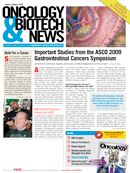Publication
Article
Oncology & Biotech News
AUA Updates Prostate Cancer Guidelines
Author(s):
The first revision in 12 years, the new guidelines are based on a growing body of evidence-based research and emphasize communication with the patient regarding risk, treatment options, and potential outcomes.
The American Urological Association (AUA) released its updated comprehensive guidelines for the management of clinically localized prostate cancer. This update represents the first revision to the AUA guidelines since they were initially published in December, 1995. The new guidelines emphasize communication with the patient regarding risk, treatment options, and potential outcomes.
The new guidelines are based on a growing body of evidence-based research. According to Ian Thompson, MD, Chair of the AUA Prostate Cancer Guideline Panel, “We can now make some recommendations based on high-quality evidence.” Added Dr. Thompson, “The focus on risk stratification is one of the most important ways in which these guidelines differ from the first ones released in 1995. Categorization by risk helps determine the patient’s risk of cancer recurrence and how effective treatment will be.”
The new guidelines define low-risk patients as men with a prostate-specific antigen level of ≤10 ng/mL, a Gleason score of ≤6, and a clinical stage of T1c or T2a, with no regional lymph node or distant metastases.
New recommendations include encouraging patients to enroll in clinical trials and avoiding hormone therapy unless the patient has symptoms or a short life expectancy, or if the tumor is extensive or poorly differentiated.
Key recommendations in the new guidelines include the following:
• A categorization of risk should be established before treatment decisions are made. Risk stratification for early prostate
cancer in men is based on PSA level, Gleason score, and clinical staging of the tumor, and is categorized as low,
intermediate, or high.
• Clinicians should communicate with their patients regarding risk, treatment options, and potential outcomes for prostate
cancer.
• The principal treatment options for low- and intermediate-risk localized prostate cancer include active “watchful waiting”,
interstitial prostate brachytherapy, external-beam radiotherapy, and radical prostatectomy with higher-dose radiation.
• Intermediate-risk patients who choose external-beam radiotherapy should be informed that adding hormone therapy may
improve survival.
• Patients should be informed that when considering ‘watchful waiting” versus surgery, the latter may improve survival and
reduce the risk of recurrence.
• For high-risk patients, recurrence is common; hence, adjuvant hormonal therapy may prolong survival.
• The use of hormone therapy as an initial treatment for men with localized prostate cancer is seldom indicated.
• Minimal data are available for the following interventions: high-intensity focused ultrasound, cryotherapy, high-dose rate
interstitial prostate brachytherapy, and primary hormonal therapy. Conclusions regarding outcomes associated with these
treatments cannot be made.
• The patient’s life expectancy, overall health, and the aggressiveness of the tumor should be taken into account when making
treatment decisions.
• Patients with localized prostate cancer should be offered the opportunity to participate in clinical trials if they meet inclusion
criteria.
The AUA recommendations are consistent with those in the prostate cancer guidelines issued recently by the National Comprehensive Cancer Network, which state that: (1) the options for primary management of prostate cancer are surgery, radiation therapy, or close observation; (2) treatment decisions should be based on the aggressiveness of the tumor, the stage of the tumor, and the life expectancy of the patient; (3) only thorough discussion between physician and patient of all three choices can lead to an optimal treatment decision; and (4) advanced prostate cancer is best managed with hormone therapy and, eventually, chemotherapy.
Clinicians today are more likely to diagnose prostate cancer in its early stages than they were a decade or more ago. Furthermore, patients today are better informed and more likely to take an active role in treatment decisions than they were in previous decades. Unfortunately, mortality rates for prostate cancer remain high. The new AUA guidelines are based on a 6-year review of more than 12,500 scientific publications, and offer the clinical community the most thoroughly researched evidence-based treatment recommendations to date.
Journal of Urology
The new AUA guidelines appear in the June issue of .


















%20(2)%201-Recovered-Recovered-Recovered-Recovered-Recovered-Recovered-Recovered-Recovered-Recovered-Recovered-Recovered-Recovered-Recovered-Recovered-Recovered-Recovered-Recovered.jpg?fit=crop&auto=format)
%20(2)%201-Recovered-Recovered-Recovered-Recovered-Recovered-Recovered-Recovered-Recovered-Recovered-Recovered-Recovered-Recovered-Recovered-Recovered-Recovered-Recovered-Recovered.jpg?fit=crop&auto=format)